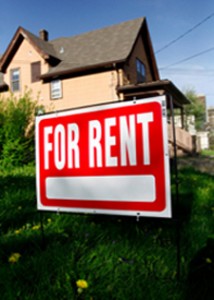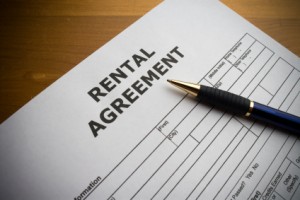Posted by Teresa on April 22, 2011 under Lease and Rental Agreements, Screening and Background Checks | 
 When a landlord leases a rental property to two or more tenants, and one wants to move before the lease is up, what is the best way to proceed?
When a landlord leases a rental property to two or more tenants, and one wants to move before the lease is up, what is the best way to proceed?
Some landlords make the mistake of splitting a $1000 monthly rent so that each tenant is responsible for $500—and accepting that amount from each tenant, month after month. When one tenant leaves, they worry about finding another tenant so that the remaining one can continue paying their $500.
However, the tenants are together responsible for ensuring the rent is paid in full; therefore, when one tenant moves out, the remaining tenant or tenants must continue paying the full rent on time every month. For example, if the lease runs through September and a tenant moves out in June, both tenants are still responsible for full rent until the end of September—whether that means the tenant who moved keeps paying their half on a rental they no longer live in, or the remaining tenant pays the entire rent.
In most cases, the lease will be in the names of each tenant, and each tenant is responsible for upholding its terms—including whatever penalties are in place for breaking the lease early. It is up to the tenants to work out how the full rent will be paid until the end of the lease.
Another issue some tenants raise is the security deposit. Would a tenant who is leaving early be entitled to a pro-rated portion of the security deposit they paid at move-in? Most landlords would say “no way.” It is standard practice to tie the security deposit to the rental unit. Only the tenants still living in the unit at the end of the lease would be eligible for any return of the security deposit.
Remember, if your tenant finds a new roommate, follow your standard procedures for any new tenant. This should include a lease application, thorough tenant screening and credit check, and checking all work and former rental references.
Posted by Teresa on April 19, 2011 under Rents and Deposits | 
 In a perfect world, every tenant would pay their rent online a day or two in advance, so that the funds are automatically transferred into the landlord’s preferred bank account. In this fantasy world, no rent checks, money orders, mail issues or late payments would ever need to be dealt with. Landlords know this will never happen!
In a perfect world, every tenant would pay their rent online a day or two in advance, so that the funds are automatically transferred into the landlord’s preferred bank account. In this fantasy world, no rent checks, money orders, mail issues or late payments would ever need to be dealt with. Landlords know this will never happen!
In reality, tenants come with a wide assortment of likes, dislikes and financial challenges. Some refuse to keep a checking account (or can’t get a bank to open one). Others are not computer-savvy and will be unable to navigate an online rent payment system. Online payments may be difficult for the the elderly or disabled to deal with. Still other tenants just prefer to deal in cash.
Depending on your rental property and typical tenant, it might be unrealistic to demand that all tenants mail you a check or pay rent online. Making it easier for your tenants to pay their rent on time by offering options that work for everyone might take some effort—but it can pay off. Just make sure that it works for you, as well.
Some options to consider for tenant rent payments:
- Dropping off cash or money orders on-site: this is not a good idea, as it invites theft!
- Set up a rent-receiving bank account and distribute deposit slips to tenants: Indicate each name on the slip, and tenants make deposits directly to the account. The landlord can track deposits online, and usually view and print a copy of the deposit slip.
- Collect rent personally: Many landlords prefer to pick up rent payments themselves because it gives them a chance to check on the property and have some face-to-face tenant time. It can also prevent late payments, since the tenant either has to pay up or explain why they can’t. However, this can be dangerous—especially when cash is involved.
- Provide self-addressed envelopes: Whether you provide the stamps or not is up to you; many tenants find it easy to drop a money order or check in an envelope that is ready to go. It may seem like going too far to make things easier for the tenant, but if it helps your cash flow—why not?
- Direct deposit or electronic transfer: In this situation, the tenant agrees to automatic electronic transfer from their bank account to yours on a specific day of the month. Automatic bill pay is becoming the way people pay bills, so why not rent as well?
Creative rent payment solutions can help keep your tenants paying on time–and keep you in the black!
Posted by Teresa on April 8, 2011 under Landlord Tips, Marketing for Landlords | 
 How a landlord advertises rental property is the first step in signing a lease with the best possible tenant. If you want a tenant who pays rent on time, takes care of your property and doesn’t cause any trouble, you can start that process when you place your ads.
How a landlord advertises rental property is the first step in signing a lease with the best possible tenant. If you want a tenant who pays rent on time, takes care of your property and doesn’t cause any trouble, you can start that process when you place your ads.
What to Include in a For Rent Ad
First you have to decide the basics: how much rent you’ll charge, the length of the lease, how many people your rental unit can accommodate, whether pets will be allowed and the requirements tenants must meet to qualify for a lease.
Once you’ve determined these factors, you can write your ad. Include the following:
- Number of bedrooms and bathrooms.
- Location.
- Special features, like hardwood floors, washer and dryer, water view, or proximity to trails or parks.
- Size and type of pets allowed, if any.
- Website to view photos and find additional information.
- How to contact you. Include a mobile number.
- The rent, security deposit and any other requirements that will help you screen out less-than-desirable tenants. For example, let readers know up front that you will be ordering tenant credit checks and background checks on all applicants.
What not to include:
Any language that can be considered discriminatory. Don’t mention that your rental unit is best for singles, families, elderly, young people, or those of a certain religion. Even mentioning that it’s located near a church can be interpreted that you expect to rent to church-goers.
Once you’ve placed the ad, try not to allow calls to roll to voice mail. People are impatient these days and may not leave a message or call you back.
Posted by Teresa on April 6, 2011 under Lease and Rental Agreements | 
 The utilities section in a property lease is one of the most important. It stipulates who is responsible for the utility bills associated with the rental property. Failing to specify which utilities the tenant will be responsible for can cause headaches and financial loss to the landlord.
The utilities section in a property lease is one of the most important. It stipulates who is responsible for the utility bills associated with the rental property. Failing to specify which utilities the tenant will be responsible for can cause headaches and financial loss to the landlord.
Determining who’s responsible for the unit’s utilities—and having a signed agreement—is important because it protects both the landlord and the tenant. Each utility company has different ways of handling rental properties. Once you know how things work in your area, decide which arrangement works best for your situation; there are many options, including:
- In single-family rental houses, tenant pays all utilities directly to the provider
- Landlord pays for utilities that can result in liens against property if unpaid
- Tenant pays for everything except sewer and water
- Landlord pays utilities and has tenants reimburse him
- Landlord pays only for utilities the building owner is responsible for
- Tenants pay for anything that is metered to their unit; utilities with shared meters (usually water and sewer) are paid by landlord and built into the rent
- Landlord pays for garbage and recycling pickup only
Once you determine which arrangement works best, draft your this section of the rental agreement stating that the tenant is responsible for all utilities except for those (specify them) the owner will be paying. Also include language that the tenant agrees to make the payments through the term of the lease and nonpayment will be considered a breach of the agreement. State that any past due utility bills may be paid by the owner and will be charged to the resident, along with applicable fees.
As part of your due diligence before you sign the lease, check with the utility companies to be sure the tenant qualifies for an account in his or her name. Outstanding bills may prevent this—if you sign a lease with a tenant who cannot get the utilities in their name, you’ve just wasted a lot of time working with a tenant who won’t be moving into your rental property.
Finally, most landlords we know have utilities revert to their name between tenants.
Posted by Teresa on April 1, 2011 under Landlord and Tenant FAQs | 
 Question: A landlord accepts applications from three potential roommates for a three-bedroom rental unit. The first two check out fine. The third proves to be difficult and unpleasant, even borderline verbally abusive, in all her interactions with the landlord. He decides to not even order a tenant credit report and rejects all three applicants. Is the landlord allowed to refuse a tenant for reasons other than a credit score?
Question: A landlord accepts applications from three potential roommates for a three-bedroom rental unit. The first two check out fine. The third proves to be difficult and unpleasant, even borderline verbally abusive, in all her interactions with the landlord. He decides to not even order a tenant credit report and rejects all three applicants. Is the landlord allowed to refuse a tenant for reasons other than a credit score?
Answer: Of course. A landlord may decline an applicant for any reason other than those covered under the Fair Housing Act, which bars discrimination based on race, color, national origin, religion, sex, familial status (including children under the age of 18 living with parents or legal custodians), pregnant women, elderly people, people securing custody of children and handicap (disability).
A landlord does not have to disclose reasons for rejecting a tenant—you can simply say a more qualified applicant was approved. (Under the Fair Credit Reporting Act or FCRA, a letter must be sent to an applicant if credit is declined, including for rental housing)
Question: A landlord advertises a rental property using the following language:
For Rent. 3BR apartment, 3rd floor. Not suitable for kids or elderly.
Is this discriminatory?
Answer: Yes. See above: landlords may not deny housing based on family status or age. This landlord could get in big trouble for this type of ad.
Question: A landlord starts eviction proceedings after discovering a tenant has kept a cat in her apartment—contrary to the lease, which states no animals are allowed. The tenant tells the landlord that she needs the cat because it is a therapy animal. Is the landlord discriminating against the tenant based on a disability?
Answer: It often depends on where the rental property is located. In most areas, a tenant must provide proof that the therapy or companion animal is necessary for the individual’s mental health or stability. This is usually a statement by a medical provider. The Americans with Disabilities Act (ADA) does not include companion, emotional support or therapy animals, because they have not been trained to perform tasks that benefit a disabled person.
Posted by Teresa on March 31, 2011 under Landlord Tips | 
 So, you’ve landed a new tenant for that vacant rental you’ve been showing. He paid the deposit, and you’re in the tenant background check phase of your due diligence process. Now you can take down the flier you posted at the local coffee shop, stop showing the unit and cancel your ads, right?
So, you’ve landed a new tenant for that vacant rental you’ve been showing. He paid the deposit, and you’re in the tenant background check phase of your due diligence process. Now you can take down the flier you posted at the local coffee shop, stop showing the unit and cancel your ads, right?
Sure, if you’re betting that the deposit check won’t bounce, the tenant credit report will come back at an acceptable level and the tenant’s references will all check out. But smart landlords know that anything can happen between the lease application and the lease signing. Tenants change their minds every day. References don’t check out. And credit scores are more iffy than ever these days. Maybe showing the rental property to additional prospective tenants is the better way to go.
Every landlord should have a back-up plan, just in case the shiny new tenant doesn’t prove to be 100% reliable. Besides, unless and until you have a signed lease, you don’t really have a new tenant.
There are several advantages to continue marketing a pending rental property:
- You’ll have prospects for your additional rental properties.
- Murphy’s Law says that as soon as you stop marketing one rental property, another one will become vacant!
- You can refer your prospects to other landlords in your network.
- A waiting list can move a hesitant tenant from “just looking” to “where do I sign?”
- You might find a better-qualified tenant than the one you’re working with.
Some landlords would say that “never” is when they stop marketing their rental properties. As in any profession, being proactive is better than being reactive in the rental property business. No matter how good a prospective tenant looks, make sure you have a back-up plan. Keep marketing and showing your rental unit and gather names for a waiting list—just in case the deal falls through.
Posted by Teresa on March 26, 2011 under Landlord Tips | 
 Pest control in rental properties is a continual issue in some areas—and not such a big deal in others. Unfortunately, mice (and rats) live almost everywhere, while scorpions, cockroaches and certain other multi-legged intruders are more bothersome to landlords in warmer climates.
Pest control in rental properties is a continual issue in some areas—and not such a big deal in others. Unfortunately, mice (and rats) live almost everywhere, while scorpions, cockroaches and certain other multi-legged intruders are more bothersome to landlords in warmer climates.
In years past, landlords often kept bugs under control with regular spraying of chemical pesticides. A greater awareness of the toxicity associated with these pest control treatments is prompting many rental property owners to revisit their standard control methods in favor of healthier alternatives for their tenants.
Fortunately, landlords now have more options when it comes to controlling cockroaches, ants, mice, rats, fleas, centipedes and even bed bugs in their rental properties. Cedar and other essential oils, along with enzymes are safe to use around pets, kids and food, and are used by increasing numbers of professional pest control companies.
One example is the use of microscopic animals called nematodes to control termites. Nematodes are added to water and then poured into termite nests, where they kill either the queen or enough worker termites that the queen eventually starves. Check with your pest control company to see if they offer natural and non-toxic alternatives.
Don’t forget that you can take control of certain pest problems without chemicals on your own. Peppermint oil is said to deter rats from entering an area, but it requires regular application. Keeping garbage secure and sealed tightly is another effective rat deterrent—so instruct tenants on proper garbage procedures. It’s never a good idea to put rat poison out where any other animal or child could ingest it!
Boric acid, which is very low in toxicity to people and pets, is often used to control carpenter ants and cockroaches. However, it is not always advised for use around food, where cockroaches tend to be. The best cockroach prevention is cleanliness. Frequent vacuuming, eliminating standing water and leaks, and keeping grocery bags and boxes outside are all methods that can help keep cockroaches under control.
If you’re trying to improve your green living score, take a look at one of the most toxic areas of managing rental properties: pest control. A little extra effort can keep your tenants safer and help them live healthier lives.
Posted by Teresa on March 22, 2011 under Landlord Paperwork and Forms | 
 Harry the landlord notices a broken window in Unit A during a routine maintenance visit to Unit B. He knocks on Unit A’s door to arrange a repair and is greeted by someone he’s never seen, much less approved to live there. The man asks Harry what he wants; Harry explains that he is the building owner. “Oh. I’m visiting,” the man replies.
Harry the landlord notices a broken window in Unit A during a routine maintenance visit to Unit B. He knocks on Unit A’s door to arrange a repair and is greeted by someone he’s never seen, much less approved to live there. The man asks Harry what he wants; Harry explains that he is the building owner. “Oh. I’m visiting,” the man replies.
Later, Harry asks the tenant in Unit B if she has seen the man in Unit A. “You mean Scott?” she answers. “He’s been there for a couple of months.”
There is a fine line between a visitor and an unauthorized resident. Explaining the difference to your tenants can be tough—but it’s something a landlord must do to avoid the risk and potential problems that come when unscreened and unauthorized tenants live in your rental property.
Luckily, making sure you’re legally covered is easy. Just make sure your lease specifies what tenants can and cannot do when it comes to guests.
Harry’s lease does prohibit unauthorized residents. When he brings this to Unit A’s attentions, the tenant replies that her friend is not a resident—he’s just visiting.
Harry reviewed his rental agreement and realized it didn’t specify any time limit for guests or visitors. He revised it to read:
“Persons other than those specifically listed on the Rental Agreement shall be strictly prohibited from staying in the rental unit for more than 7 consecutive days, or a total of 20 days in any 12-month period. Tenant shall notify Owner in writing any time the Tenant expects any guest will be staying in excess of the time limits herein. Additional residents will be subject to full screening procedures, additional rent and security deposit. Unauthorized residents are a violation of this Rental Agreement and grounds for termination of the Rental Agreement.”
Harry was still within his rights to notify the tenant in Unit A that her unauthorized guest had overstayed his welcome and that he would need to move or she would be in violation of her lease. Luckily, she didn’t push the issue and the visitor was soon gone.
Don’t expose your tenants or your business to the risks of unscreened residents. Require your tenants to clear it with you before allowing anyone to move in. Require the new roommate to fill out a lease application and undergo tenant screening and a background check before they unpack their first box of belongings!
Posted by Teresa on March 21, 2011 under Landlord Tips | 
 One of the biggest challenges for landlords is maintaining their rental properties. Failure to do so can lead to further damage, unhappy tenants and lower property values.
One of the biggest challenges for landlords is maintaining their rental properties. Failure to do so can lead to further damage, unhappy tenants and lower property values.
Some landlords prefer to do all their own maintenance; others are not capable or simply don’t have the time to perform maintenance. Still others make the attempt to do it themselves, only to realize they’re in over their heads.
If you’re thinking about hiring a contractor or handyman service to take care of routine maintenance and emergency repairs on your rental properties, here are a few tips.
- Do you need occasional help or a full-time maintenance person? Would you rather hire expert plumbers, electricians and carpenters each time you need specialty work? Knowing what you need is the first step. A long-term contract for routine maintenance plus regular repairs might be more economical than calling an expensive contractor for a smaller job. And don’t forget that availability is sometimes a problem with busy general contractors. A regular maintenance contract means priority when you have an emergency.
- Once you determine your rental property maintenance needs, ask for referrals.When working with an contractor, it’s sometimes difficult to know whether you’re getting a good deal and getting good work—or being ripped off. Your local builder and remodeler association is the perfect place to start your research. Also ask other rental property owners in your network. You might hear an earful about whom to avoid—and who is most trustworthy.
- Once you’ve narrowed your choices down, it’s a good idea to conduct a “job interview” with each one. Even though they will likely be a subcontractor, and not an employee, you’ll still need to be sure that there is a good rapport and mutual respect between you. If you’ve found the right person, you might be in partnership for a long time—and you want to make sure you can get along.
- Conducting due diligence on your potential handyman is another important to-do item. Check with your state licensing board to ensure your prospective contractor holds proper business and contracting licenses, and is bonded and insured. Individuals without proper licenses are best avoided. And don’t rule out conducting a background check. Anyone with access to your rental property puts you and your tenants at risk. Mitigate that risk by knowing exactly whom you are hiring. Be sure to ask for and check references before you make your final decision.
Posted by Teresa on March 17, 2011 under Landlord and Tenant FAQs | 
 Most landlords and property managers know that whether or not pets are allowed in their rental properties, exceptions must be made to accommodate companion and service animals for the disabled, under the Americans with Disabilities Act (ADA). But what functions as a service animal for a tenant might not look like a service animal to you.
Most landlords and property managers know that whether or not pets are allowed in their rental properties, exceptions must be made to accommodate companion and service animals for the disabled, under the Americans with Disabilities Act (ADA). But what functions as a service animal for a tenant might not look like a service animal to you.
A landlord might wonder how a bird or a snake could be used as a service animal. After all, it’s not as though they help the tenant cross the street.
Rental property owners and managers must remember that not all disabilities can be seen. For example, people who suffer seizures sometimes use boa constrictors to warn them of a coming seizure. The snakes gently squeeze their owners when they feel a seizure coming on, so the person can take medication or remove him or herself from a stressful setting.
Cats and ferrets are sometimes used by individuals who experience anxiety. The animals might serve to calm them down when during air or water travel. And a parakeet can help a person with severe depression by acting as the focus of the person’s care and attention. In this way, the bird improves the person’s daily functioning—which is the definition of a companion animal.
The ADA rule covering companion animals requires tenants to obtain certification by a medical professional that the animal is necessary to relieve the disability. If a tenant has such an order, then the rental property owner or manager must make reasonable accommodations for the animal. And remember, service animals are not pets.
The U.S. Department of Justice is currently trying to define service animals. Last year, it received thousands of comments when it announced plans to exclude from the definition wild animals and service animals whose sole function is to provide emotional support, comfort, therapy, and companionship, and to promote emotional well-being. We will keep you posted on what the DOJ decides!
Pre-screen all tenants as part of your standard application process. Background and credit checks will help ensure you rent to qualified tenants. For more landlord resources, including forms and information on tenant screening, turn to E-Renter.com.
 When a landlord leases a rental property to two or more tenants, and one wants to move before the lease is up, what is the best way to proceed?
When a landlord leases a rental property to two or more tenants, and one wants to move before the lease is up, what is the best way to proceed?








